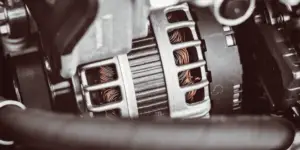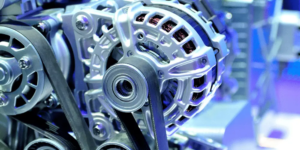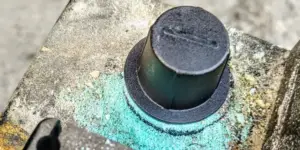The starter often gets overlooked when a car fails to crank. Inexperienced drivers or people with not much mechanical knowledge often wrongly point the finger at the battery or alternator.
Here we’ll look at the signs of a bad starter in a lot of detail, but before we get into it briefly, the signs are either
- Grinding noise when turning the key
- Continuous buzzing noise
- Smoke
- Whirring noise
- Freewheeling starter gear
- Loud clicking noise
- The starter stays on after the car is running
- Temperamental starter
A lot of noises in the list, I know. Each one indicates a different fault within the starter, though.
Signs of a Failing Starter Motor
1. Grinding Noise
A grinding noise indicates that the gears or the flywheel have some missing teeth.
The gears have to engage the flywheel correctly. If they are slightly misaligned, they will grind away until all the teeth on the flywheel or flexplate have gone.
If you hear this noise and do nothing eventually, you’ll hear nothing.

That indicates the gear and flywheel are now freewheeling as the teeth have worn back and aren’t engaging anymore.
If you hear this noise – depending on your car – you’ll have to remove the intake manifold to access the starter.
Often the starter sits under the engine, and a lot of labor hours are required to inspect it. Once the starter is out, you won’t have to dismantle it further as the teeth are visible.
The good news is that if these teeth are okay, then the flywheel or flexplate teeth should also be okay, as one of these parts will always damage another.
As always, disconnect the battery as the starter is always live and hot.
2. Buzzing Noise
A continuous buzzing sound when you turn the key inside the ignition can result from a drained battery or,
In other cases, corroded electrical connections inside the starter system.
Always best to check the battery first as this will always be the cheapest fix.
If the battery is fine, it’s then a case of getting to the starter itself to see the condition of the connections.
3. Freewheeling
Bad news. This is caused when the flywheel is not getting engaged by the starter. Therefore, it cannot transfer power between the engine and the transmission.
You might be fortunate if the starter gear is loose and not pushing the gear forward- especially if you’ve heard no grinding noise before the freewheeling started. This is a cheaper fix.
4. Smoke
If the battery transmits too much power to the starter, you may get smoke – usually briefly.
This can also happen if the bushings at the end of the rotor are worn.
Don’t keep trying to crank the engine if you see smoke. Stop immediately as there is a slim possibility the starter can be repaired. Continually attempting to crank will kill the starter.
5. Loud Clicking
A clicking sound when cranking your engine is normally a sign – but not always- of an electrical problem rather than a mechanical issue.
A mechanic will always check the solenoid first using a voltmeter. There could be an open circuit, and that will cause the click. It’s a good idea to check the entire length of the cable for wear. Also, they’ll clean all the connections too and make sure they are tight to ensure grounding.

6. Starter Remains on After Starting the Engine
When you turn the key (or press the starter button in modern cars) and the engine starts successfully, you release the key. This action cuts off the power to the starter motor.
If the starter stays on when your engine is running, it means that the solenoid contacts are welded closely together, and the gear is not retracting.
You should get it fixed immediately because if it is left unsolved, the starter relay will stick to the on position, eventually damaging the entire starter system and even the flywheel.
7. Whirring Noise
The starter motor has a pinion gear that connects it to the flywheel. If it fails to engage with the flywheel, it will begin spinning on its own and make a whirring noise.
This is usually a better noise than a grinding noise as no mechanical parts are damaged. There will be no crank when this happens. The worst-case scenario is the solenoid needs replacing. The best case is a loose connection.
8. Sporadic Issues When Starting the Car
Sometimes you turn the key, and the car doesn’t start as it should, but after a few tries, the engine cranks up, and you are ready to go.
Continually turning the key is not good.
Please don’t risk it. Get the starter checked out; otherwise, parts within it or the flexplate or flywheel could be damaged beyond repair.
Can a Starter Be Repaired, or Do I Need a New One?
Unless you are a competent DIY mechanic, take your car to an auto electric shop.
If you’ve noticed the problem soon enough, the starter can probably be salvaged – although this may not be economical to do with many faults.
It’s rarely a quick fix, though, so don’t expect to get your car back the same day. As discussed – the make and model of your car dictates where the starter is located and the work involved to get to it.
Often it’s next to the transmission and behind the engine in most front-engine vehicles.
In some cars, you can access it from above, but in other vehicles, you need a jack or a ramp to get underneath.
Starter Replacement Costs
It isn’t easy to estimate the cost of starter repairs. It depends on whether the solenoid or gears are defective and the location of the starter itself. Add in the variance due to the make and model of cars, and the difference in aftermarket parts prices leads to a wide disparity.
The largest cost is the labor costs – the starter itself is cheap in comparison – so rather than repairing the gears or the solenoid, it often makes better sense to replace the starter completely. It’s quicker and more convenient too, as most car shops will send the solenoid away to be fixed rather than do it themselves on-site.
There’s a chance that if the gear is damaged, then the engine flywheel is too. This is an expensive repair. Hear grinding? Stop trying to crank immediately!
Expect to pay $100 to $350 for a new starter. Labor costs vary depending on the time taken getting to the old starter. Labor fees are approximately $200 to $350, depending on the location of the starter in the engine bay. In total, the cost varies between $300 and $700.
Can You Jumpstart a Car With a Bad Starter?
You can jumpstart a car with a bad starter, but this only boosts the battery power and does nothing to help the starter to turn. You’ll be more likely to damage the starter beyond repair – if it had a chance of being repaired cheaply – by continually trying to get it to crank the engine.
Car Battery Smells Like Rotten Eggs – Yes, It’s Dangerous
In Conclusion
- The engine won’t turn the crank.
- Clicking, grinding, or whirring noises
- Intermittent Starting.
- The starter Stays On After Starting. …
- Smoke from the starter
- The starter engages but the engine won’t start.
- The battery getting hot.
The parts that fail are either the solenoid – the electrical part or the gear – the mechanical part.
If the gear fails, it may also damage the flywheel – attached to the engine, and the repair costs can run into thousands of dollars.
It’s often more convenient and cheaper to get a brand-new starter than to repair a damaged one.
Only a competent DIY mechanic or a car shop should work on a bad starter.













